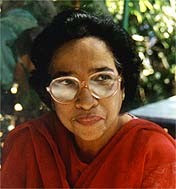Some people are born artists and Baya or Fatima Haddad of
Algeria was one such gifted person. Born in 1931 at a village called Bordj El
Kiftan in Algeria, her talent for painting was evident even before the age of
ten.
Orphaned at the age of five, she was brought up by her
grandmother. As a teenager she worked in the house of a French lady Marguerite
Caminat, as a domestic help. This lady spotted her talent and encouraged Baya
to draw and paint, even supplying her with paint, paper and whatever else she
required. Later, Baya was legally adopted by her.
Marguerite was well connected in the Art and Literary
world. She showed Baya’s paintings to an Art dealer Aimee Maeght. Impressed by
her talent, Aimee who was the Director of Maeght Art Gallery in Paris,
organized a solo exhibition of Baya’s paintings in 1947. She was just sixteen
years old and found herself suddenly in the limelight. Andre Breton, Founder of the Surrealist
Movement was impressed by her work and saw in her paintings a surrealistic
dream like quality. In the Exhibition Catalogue he wrote that he was “promoting
the beginning of Queen Baya.”
But Baya refused to have her work compartmentalized under
any genre. “I am a free spirit and paint the world within me,” she said. “When
I paint I am happy. I am in another world. I forget everything.”
Picasso met the teenaged Baya and was impressed with her
work and the spontaneousness in her figures. In 1948 he invited her to work
with him. It was a case of mutual admiration. They inspired and appreciated
each other’s work. Though Picasso was fifty years older than her, she gave him
fresh perspective and inspired him to paint a collection of women called “Women
of Algeria.” An Art historian commented “Picasso nurtured Baya’s aesthetic –
particularly her use of colour and line, while Baya’s cultural vitality served
as a creative life blood for Picasso.”
In 1952 Baya married an Algerian musician and composer
Maheidinne Mahfoudh. Baya threw herself into domesticity, temporarily forsaking
painting, to bring up six children in the years between 1953-1963. But she
returned to painting in 1967 with renewed vigour. She was completely self-
taught and painting was her passion. Totally illiterate, she could barely sign
her name.
Baya’s output was copious. Her subjects were women in
colourful dresses, children, animals, flowers, fish and butterflies. Her
colours were vibrant, her outlines bold and well defined. Baya’s work was
exhibited in Paris and Algeria. Some of her paintings were printed on postal
stamps. She also tried her hand at pottery.
Critics called her work primitive, naïve or surreal. Some
saw similarities with Islamic or African tribal art. It did not bother her or
affect her work. She only allowed her environment and imagination to influence
her artistry.
Though invited to settle in France, Baya preferred to
stay in Bilda Algeria until her death on November 9th, 1998. This humble
lady’s tribal art fascinated the western world.







